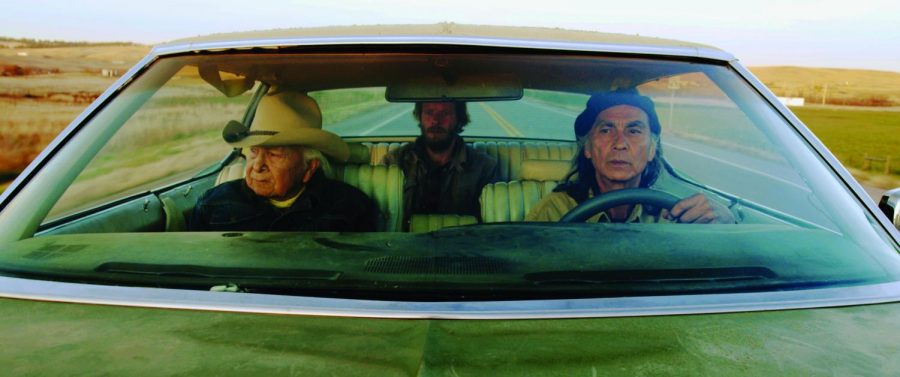Independent Native American film debunks classic stereotypes
Photo Courtesy of Inyo Entertainment
“Neither Wolf Nor Dog,” is an independent Native American film currently playing at the Goodrich Savoy on Oct. 8 and Oct. 11. Based on a novel, the film provides insight to modern Lakota life, and has had widespread success across the U.S., with a 95 percent on rottentomatoes.com. (From left to right) Dave Bald Eagle, Chris Sweeney and Richard Ray Whitman were the central cast.
October 8, 2018
On a Saturday morning at the Goodrich Savoy 16 IMAX theater, community members and moviegoers shuffled into the 9:30 a.m. screening of the independent Native American film “Neither Wolf Nor Dog.” Once the credits rolled, the audience members remained in their seats, taking a moment to reflect on the film they saw.
“Neither Wolf Nor Dog,” an independently made and self-distributed 2016 film, has an audience score of 95 percent on rottentomatoes.com. The movie will be playing at Goodrich Savoy Oct. 8 at 7 p.m. and Oct. 11 at 3 p.m.
The film, based on the book of the same name, follows real-life author Kent Nerburn as he is asked to document the lessons learned from one of the last generations of Lakota elders. “Neither Wolf Nor Dog” depicts modern Lakota life and the generational effects of government-led displacement and assimilation efforts on native reservations, specifically the 1890 Wounded Knee Massacre where 300 Sioux people were killed.
The film’s director, Steven Lewis Simpson, attributes much of the film’s success to 95-year-old lead actor Dave Bald Eagle, who played Lakota elder Dan.
“(The audience has) fallen so in love with Dave and what he’s done with this film and the journey around it,” Simpson said. “It’s how he’s made them feel that’s made them vote the way they have.”
Get The Daily Illini in your inbox!
Bald Eagle, who passed away before the film’s release, is the heart of the movie. His character inherently demands respect by his status on the reservation, but his individual charisma is captivating as well. Bald Eagle’s comedic timing combined with his gentle yet commanding onscreen presence demonstrates the versatility of his talent. He can elicit the most laughter from the audience with one-liners and simultaneously deliver thought-provoking monologues.
Simpson actually had Bald Eagle improvise a climactic scene of the movie, filmed at Wounded Knee. Bald Eagle, whose own family was more directly affected by the massacre than the character, channeled his own history to convey the vulnerability and honesty of the moment.
“We set the camera on close-shot on him and told him, ‘Tell us what you feel,’” Simpson said. “And he switched into an emotional place and poured his heart. At the end of the sequence, he turned to Christopher Sweeney who was playing Nerburn, the author opposite, and said, ‘I’ve been holding that in for 95 years.’”
Since its release in 2016, the film has been in nearly 200 theaters across 15 percent of the country. Simpson said that some dedicated fans drive six hours or even hop on a plane just to see the movie.
Melody and Holly Bass, mother and daughter and descendants of the Standing Rock tribe, took off of work and drove from Decatur to Savoy to see the film. They were impressed with the full theater and the overall response.
“I’m not sure there would have been as big of a turnout in Decatur because I don’t think people think that way there,” Melody said. “But here, because of the University, because of the value on education, there was a good turnout.”
They haven’t always been impressed with the University. Holly, former student in ACES, transferred amid the Chief controversy. She felt like her feelings didn’t matter to other students and faculty.
“We like to say we’re people with a past, not a people of the past,” Holly said. “I’ve lived in Illinois my whole life and I’ve grown up around non-natives and they’re like ‘You still exist?’ It’s like to be told people don’t even realize you exist.”
Both Melody and Holly thought the film debunked cultural stereotypes and filled a disparity for modern representation of reservation life in media.
Suzanne Wannemuehler, volunteer at Red Feather Development, a nonprofit that builds homes on native reservations, found both the book and film to be enlightening.
“As a white person going to the reservation, I made so many cultural mistakes, never even realizing how many cultural mistakes I was making,” Wannemuehler said. “This book I read helped teach me about what not to do. And quite frankly, the movie versions many of us have about what it means to be Native American are just that: make-believe.”
Simpson believes the authenticity of the film stems from his individual-first approach. For him, Simpson said the last thing someone should ever do is approach a film from a cultural standpoint because then it immediately fails.
“Then you draw on stereotypes and too great of a simplification,” he said. “My role was to know who Dan was, (who) Grover was, Winona and various other characters as individuals. And if I create those individuals truly, then everything else falls into place because everything that is true to them, cultural and otherwise, will be in place.”
There are various campus efforts happening at the intersection of art and native representation too. Nichole Boyd, director of the Native American House, is organizing the events for Native November. Various artist talks with visual artists Ryan Young and Broadway star Ty Defoe will be held throughout the month in addition to bead making, basket weaving and cooking demonstrations.
“Oftentimes people hear (of) Native American art, and they put natives in this,” Boyd said. “(So) if you’re not producing stuff like this quintessential warrior on a horse riding through the plains, then people have a hard time grappling whether that’s in their box when they think of Native American art.”
Simpson has already taken the film overseas, where it outperformed other films at a Belgium film festival. He hopes to take it to other places in Europe.
“In Europe, there’s more of a general cultural fascination,” he said. “Everyone in Europe is so used to American movies, but this is taking them into the country in ways they’ve never been before.”








